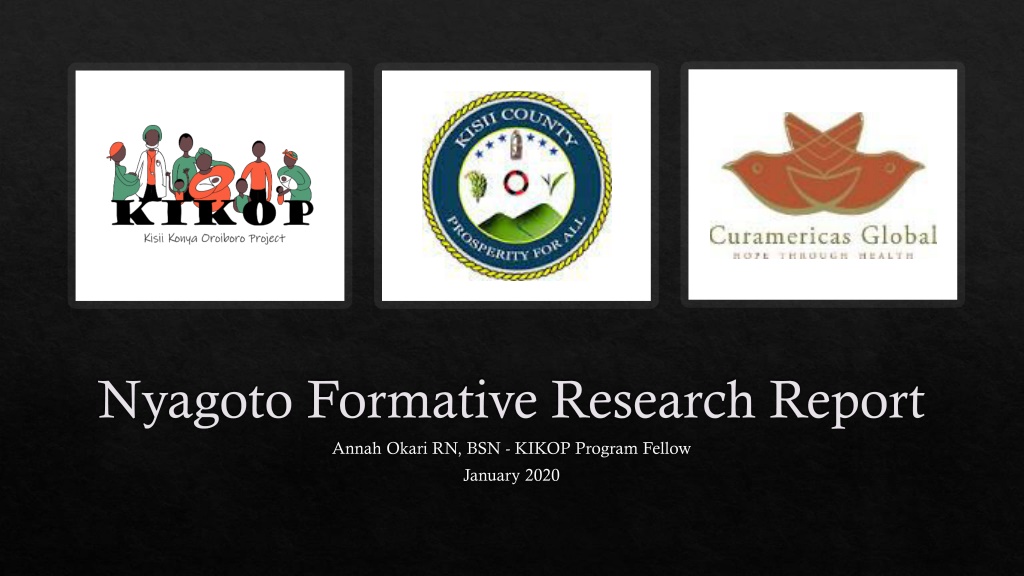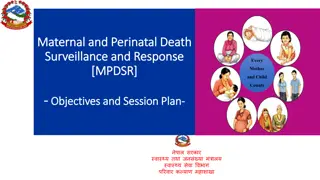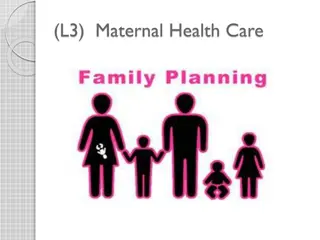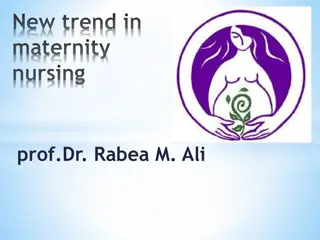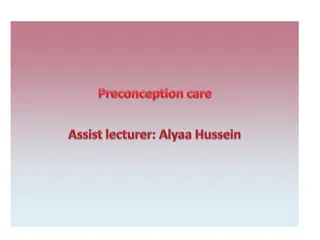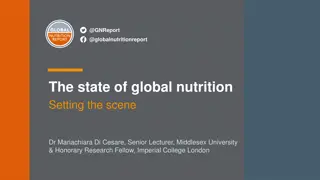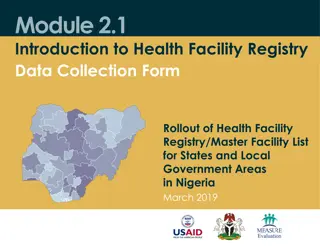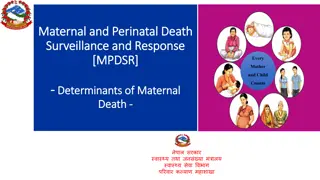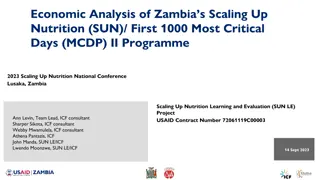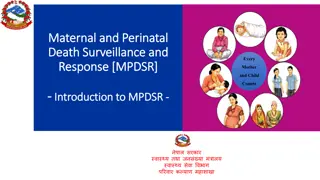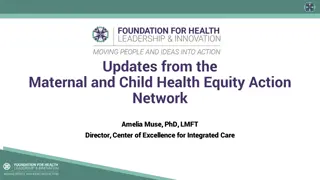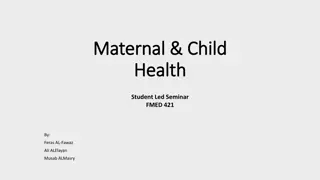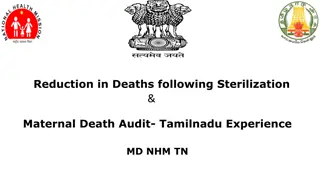Understanding Child Stunting, Maternal Deliveries at Home, and Health Facility Status in Nyagoto
Research conducted by Annah Okari RN, BSN, for the KIKOP Program Fellow in January 2020 explores contributors to child stunting and malnutrition, reasons why women still deliver at home, and the current status of health facilities in Nyagoto.
Download Presentation

Please find below an Image/Link to download the presentation.
The content on the website is provided AS IS for your information and personal use only. It may not be sold, licensed, or shared on other websites without obtaining consent from the author. Download presentation by click this link. If you encounter any issues during the download, it is possible that the publisher has removed the file from their server.
E N D
Presentation Transcript
Nyagoto Formative Research Report Annah Okari RN, BSN - KIKOP Program Fellow January 2020
Formative Research Objectives Objective 3: Contributors to child stunting and malnutrition Objective 1: Why women are still delivering at home Objective 2: Health facility status and needs Objective 5: Stakeholder roles and contribution to maternal and child well-being Objective 4: Why women are delaying care-seeking during OB emergencies
Informants Community Health Volunteers (CHV s) Clan Elders Community Health Extension Workers (CHEW s) Mothers who Delivered at Home Mothers who Delivered at the Health Facility Traditional Birth Attendants (TBA s) Nyagoto Health Facility Staff
Theme 1: Reasons for Home Delivery Social contributors Poverty Poor Education Fear Mistreatment Lack of privacy
Theme 1: Reasons for Home Delivery Many women give birth at home because they can t afford hospital expenses as compared to delivering at home. You get that you don t have transport means or expenses, or you don t have even soap, or clothes to wear to maternity. Sometimes there are some fee we pay when we are tested at the hospital, so you prefer to give birth at home hoping that all go well and only go to hospital for clinic and other services. TBA
Theme 1: Reasons for Home Delivery I just fear doctors The doctors (nurses) shout at you, they do not attend to you, they'll just leave you there then go to attend to other things. Mother who Delivered in Facility
Theme 1: Reasons for Home Delivery Environmental factors Hilly terrain Living far from facility Bad roads
Theme 1: Reasons for Home Delivery That is a huge challenge for us. First, the topography of this area is hilly, so you find that women wait till the last minute and since this is the only hospital in this area and it serves two locations, access becomes difficult. This is also a dispensary so if they come at night, there may be no provider. They prefer to come when they know there is a provider or go to further facilities, for example Marani. In the process, some end up delivering on the road or at home. Sometimes it may rain, making it hard to use the roads. CHEW
Theme 1: Reasons for Home Delivery Facility contributors No maternity wings Few providers Being charged for free services Male provider Frequent vaginal exams Health facility hours of operation
Theme 1: Reasons for Home Delivery If it is possible, we would ask to get a doctor who stays over at the facility at night since there are a lot of people who get sick at night and even most pregnant mothers usually give birth at night but do not find somebody to attend to them. So, what we can ask is for somewhere the doctors can stay so that they can be accessible even at night. - CHEW
Theme 1: Reasons for Home Delivery Another thing is medicine. The doctor had told us that being tested is free but it is not free since after being diagnosed they would tell you what you are ailing from, let us say it is malaria or Typhoid, however we do not have the medicine, it is around 1000 shillings you can go buy from Nyachenge or Marani. That is one of the things that make the people feel like the services are not free since they expect everything is from the government therefore it should not be charged. Clan Elder
Theme 2: Respectable, Culturally Sensitive Maternal Care Respectable Maternal Care Honesty Privacy Non-discriminatory
Theme 2: Respectable, Culturally Sensitive Maternal Care I believe KIKOP has come to make services better. In this facility, there is no secrecy, a lot of people know a lot about others. For instance, now, all the people who are HIV positive, are known by the community since there is no secrecy. This makes a lot of people to opt to go to Karachuonyo so as to ensure their privacy. So we would encourage there to be some secrecy that is why the consultation room has a door so that one can discuss their issues with a doctor at a personal level. So I would like to ask secrecy to be kept. Clan Elder
Theme 2: Respectable, Culturally Sensitive Maternal Care To be honest, there is selectivity in service provision. If I go to the clinic, as a teacher, a nurse will leave the patients who arrived before me because she knows I will give her even 500 ksh. So, she leaves those who came first to see me. CHV
Theme 2: Respectable, Culturally Sensitive Maternal Care Culturally Sensitive Maternal Care Ululation Okoiririata Rirongo Etamama or Ensio
Theme 2: Respectable, Culturally Sensitive Maternal Care Yes, we are aware of them especially if your husband is seeing other women out of the marriage, you are supposed to be given some something called rirongo so that if your husband comes to see you do not die. We would love to ask if they can have it at the hospital so that we can take it (rirongo) so that we do not die if they come to visit since we cannot tell if they are faithful or not. Mother who Delivered in Health Facility
Theme 3: Ways to Improve Health Facility Use Ongoing CHV registration of pregnant women LLITN provision following facility delivery Improved customer service (shorter wait times) Health education regarding free maternity and importance of facility delivery during barazas
Theme 3: Ways to Improve Health Facility Use Education is also key. When women come to the hospital for ANC services, they are told the importance of coming to the hospital when pregnant, so we usually educate them to come for those services. At home we have also worked to register those who are pregnant and ensure that we monitor them from the first ANC up to delivery. CHEW
Theme 3: Ways to Improve Health Facility Use Desired CHVs to educate community on maternal and child health More staff in facility - with provider specifically for OB care 24/7services Incentives for delivering mothers, CHV s, CHEW s and TBA s Clan elder involvement in health promotion Improved customer service - prompt and respectful attention, privacy, no beatings, allow mothers to choose birth positions, assigned provider, less vaginal exams, Adequate supplies/equipment Inclusion of traditional practices
Theme 3: Ways to Improve Health Facility Use Our facility is good but does not have most of the medicine. Most of the time we are told to go buy the prescribed medicine because they are not in the hospital. So that discourages most of the people from coming to the facility since they will be told to go to buy elsewhere. So, they will prefer to go to a facility that has enough medicine. It is hard to determine when the medicine was restocked last since every time, they are out of them. That is why we do not trust our facility that much; we are not sure if they are given little supply of medicine always. There is medicine that is very expensive, but they are not found here, that leaves us questioning and thinking the facility is okay but is not supplied with medicine. We would like to come knowing that if we go to that facility we would be treated and be medicated without being referred to go buy medicine elsewhere. Most of the time you would just be given Panadol and be told to go find the rest of the drugs. Clan Elder
Theme 4: U2 Malnutrition Contributing Factors Poverty Shame Substance Abuse Poor child spacing
Theme 4: U2 Malnutrition Contributing Factors What contributes as well is our husbands, you would have given birth after a like one month they would want to have sex and if you tell them they are not ready they would tell you that they deserve their right. This then leads to another pregnancy and another one. So from my view, both parents should be advised on how to do family planning. This misunderstanding is also a contributing factor to children being born at a close range. Clan Elder
Theme 4: U2 Malnutrition Solutions Education Nutrition, kitchen gardening, exclusive breastfeeding, handwashing, and nutritional value of foods Family Planning Child spacing Birth control Health Providers/CHV roles Nutrition assessment and growth monitoring Supplement provision Mass nutrition screening Food distribution In-house nutritionist
Theme 4: U2 Malnutrition Solutions Some of us have had around 5 children and we do not intend to exceed that, so sometimes we try the recommended family planning methods like the needles and tablets however they do not work. Even the one for inserting sometimes you do not agree. So we would need family planning method sensitization. - Mother who Delivered at Home
Theme 4: U2 Malnutrition Solutions That is what we do in the community. We encourage them to have a variety of food through kitchen gardening. There they can plant different vegetables and fruits. We also discourage use of packaged foods such as biscuits. Traditionally, women used to feed children food from their gardens and that's what we encourage them to continue practicing. And also we tell them to do exclusive breastfeeding and not introduce food too early. ... . We also use CHV to educate them regarding various foods. Women should not sell beans to buy mandazi or kangumu. So we educate them regarding the various types of foods available in the village that can improve their children's nutrition. ..... And also for them to come for growth monitoring so the status of their child is known. The child is also given supplements. CHEW
Theme 5: Desired KIKOP Contributions PROMOTE COLLABORATION BETWEEN HEALTH FACILITY STAFF, CHVS, TBAS, CHEWS, AND CLAN ELDERS PROVIDE INCENTIVES HEALTH FACILITY CAPACITY BUILDING
Proposed Interventions Improve attention to obstetric emergencies with the goal of reducing maternal and neonatal mortality Increase access to quality, respectful maternal/newborn services Increased provision of essential newborn care Promote responsible and safe reproductive health behaviors among adolescents ages 10-19 Reduce stunting in under-two children
Questions and Comments Questions Comments
